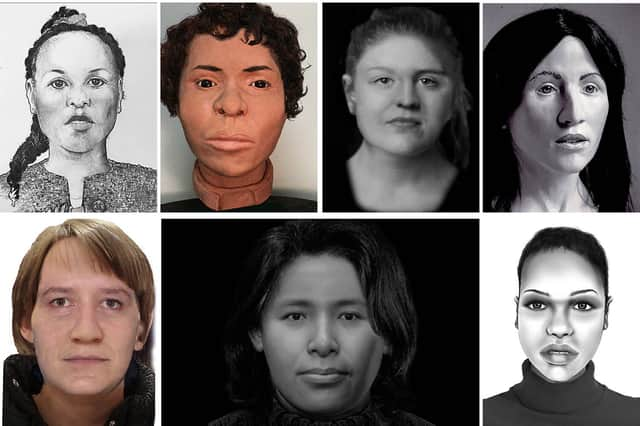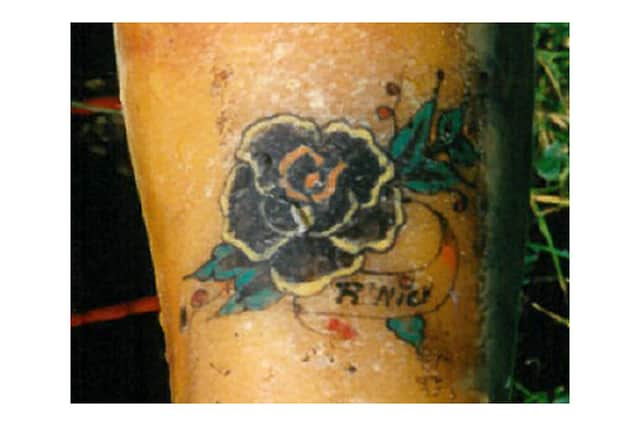Operation Identify Me: Interpol launch campaign to give names back to 22 women - most of them murder victims
and live on Freeview channel 276
Warning: readers may find some of the content and images distressing
"They are someone's friend, sister, cousin, daughter or mother. And they matter."
Advertisement
Hide AdAdvertisement
Hide AdThis from Interpol, which has teamed up with Belgian, Dutch and German police forces to launch Operation Identify Me on Wednesday (10 May), a campaign aimed at seeking the public’s help in identifying 22 dead women - all of whom they believed were murdered.
Interpol has released new information on the 22 black notices - used to seek information on unidentified bodies - available to the public on its website for the first time. The notices include details of when and where the women's bodies were found, characteristics like estimated age, height, hair colour, and eye colour - and facial reconstructions where possible.
Videos and pictures of items like jewellery, clothing, tattoos, and bags which were found on or with the women’s remains have also been included, to help give the public a greater chance of recognising them.


Carina van Leeuwen and Martin de Wit of the Netherlands Police - which initiated the public appeal - said in a statement most of the 22 victims died violently. "Some were also abused or starved before they died."
Advertisement
Hide AdAdvertisement
Hide AdMany of the women were most likely not from the countries they were found in, the statement said, and as such, their identities have not yet been established. "It is possible that their bodies were left in our countries to impede criminal investigations."
Police believed some of the murdered women may have come from specific regions in Eastern Europe, and identifying them may also provide evidence on the perpetrators of these crimes. Anja Allendorf of the German police said: “In similar investigations, establishing the victim’s identity ultimately has led to the arrest of a suspect.”


Carolien Opdecam of the Belgian police added: "We want to stress that we are looking for names... The victim’s identity is often the key to unlocking the mysteries of a case.”
Until their names are discovered, Interpol has given the cases individual monikers based on unique features, such as 'The woman in men's clothing'; 'the woman with the flower tattoo'; or 'the burned body in the forest'. They all died over a period of 43 years - between 1976 and 2019.
Advertisement
Hide AdAdvertisement
Hide AdAll of their bodies were found in either Belgium, the Netherlands, or Germany, and their estimated ages range from 13 to 55. Many appear to have suffered extremely violent deaths. In some cases their remains had been hidden in forests, wrapped in blankets.


A number were also found in waterways, some partially dismembered, or in one instance, encased in concrete. One woman was even found in a rainwater well in Belgium, where she may have been for as long as two years.
In a social media video launching the campaign, local celebrities from the supporting countries, including actresses Carice van Houten and Veerle Baetens, singers S10 and Axelle Red, boxing champion Regina Halmich and sports reporter Katrin Müller-Hohenstein, said: "In our home countries, in Germany, Belgium, and the Netherlands, several women and girls were found murdered.
"We still don't even know their names... We don't know who they are and where they are from. It's been like this for years and years." They added: "Somewhere in the world, these women must have family and friends, brothers and sisters, fathers and mothers, sometimes children. They deserve answers."
Advertisement
Hide AdAdvertisement
Hide Ad"Give these women back their identity. Don't let these girls be forgotten," the group urged.
Susan Hitchin, who co-ordinates Interpol’s DNA unit, said identifying the women could help bring closure to family members, who have lived with uncertainty for decades, in some cases. “It’s horrendous to go all these years without having any news, not knowing what’s happened... However dreadful it may be to get that confirmation that their loved one has died, it is part of an important process in order to grieve and to move forward."
She added: “Hopefully a member of the public will able to bring some new elements that the police can use that will ultimately provide the identity to these victims and ideally help lead to the perpetrator, if there is one.”
